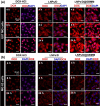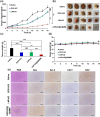Biomimetic cancer cell membrane engineered lipid nanoparticles for enhanced chemotherapy of homologous malignant tumor
- PMID: 40596990
- PMCID: PMC12211940
- DOI: 10.1186/s12885-025-14433-0
Biomimetic cancer cell membrane engineered lipid nanoparticles for enhanced chemotherapy of homologous malignant tumor
Abstract
Background: The advancement of biomimetic drug delivery systems designed for biomedical applications has attracted considerable attention from researchers in recent years. A particularly noteworthy approach involves the use of various cell membranes, which can impart distinctive functionalities to the nanoparticles, including specific recognition of target cells, prolonged circulation within the bloodstream, and enhanced ability to evade the immune system, as surface coatings on nanoparticles. This innovative strategy has positioned cell membrane-coated nanoparticles (CMCNPs) as a promising framework for addressing a wide range of diseases more effectively.
Methods: In the current investigation, lipid nanoparticles were specifically engineered using glioblastoma cell membrane (GBMM) coatings, termed as LNPs/D@GBMM, to serve as targeted nanotheranostics against homologous malignant glioblastoma (GBM). The physicochemical properties of LNPs/D@GBMM were investigated in terms of particle size, morphology, drug loading (DL), drug release behavior and so on. Homologous cellular uptake was evaluated by confocal laser scanning microscopy (CLSM). Cell cytotoxicity was evaluated by MTT assay. Moreover, the bio-distribution of CMCNPs in vivo was investigated via the near-infrared (NIR) fluorescence imaging technique, and the anti-tumor effect in vivo was evaluated in xenografted nude mice.
Results: Compared to non-targeted lipid nanoparticles, LNPs/D@GBMM exhibited superior cytotoxic effects against homologous tumor cells. In addition, fluorescence imaging of targeted tumor cells treated with LNPs/D@GBMM indicated a marked increase in cell internalization, and improved fluorescence distribution in vivo. LNPs/D@GBMM finally produced an excellent tumor suppression effect on homologous tumors.
Conclusion: The robust platform established by CMCNPs leveraging the inherent characteristics of homologous tumor cell membranes, is expected to facilitate systemic delivery of therapeutic agents specifically aimed at treating tumors, thus advancing the efficacy of cancer therapy in clinical settings.
Keywords: Biomimetic drug delivery systems; Cell membrane; Glioblastoma; Homologous tumor; Lipid nanoparticles.
© 2025. The Author(s).
Conflict of interest statement
Declarations. Ethics approval and consent to participate: All animal experiments were housed under a specific pathogen-free barrier facility and all procedures were approved by the University Committee on the Use and Care of Animals of Gannan Medical University of China (approval number: SYXK(Gan)2023-0004, approval institution: Science and Technology Department of Jiangxi Province). Consent for publication: Not applicable. Competing interests: The authors declare no competing interests.
Figures








Similar articles
-
Targeted delivery of DAPT using dual antibody functionalized solid lipid nanoparticles for enhanced anti-tumour activity against triple negative breast cancer.Int J Pharm. 2025 Feb 10;670:125142. doi: 10.1016/j.ijpharm.2024.125142. Epub 2024 Dec 31. Int J Pharm. 2025. PMID: 39746584
-
Nanoparticles Loaded with Pralidoxime Wrapped in Tumor Cell Membranes: A New Strategy to Counteract the Central Nervous System Effects of Organophosphate Poisoning.Int J Nanomedicine. 2025 Jun 24;20:8101-8118. doi: 10.2147/IJN.S516233. eCollection 2025. Int J Nanomedicine. 2025. PMID: 40584778 Free PMC article.
-
Ginsenoside F2-modified liposomes delivering FTY720 enhance glioblastoma targeting and antitumor activity via ferroptosis.Phytomedicine. 2025 Aug;144:156917. doi: 10.1016/j.phymed.2025.156917. Epub 2025 May 30. Phytomedicine. 2025. PMID: 40480023
-
A rapid and systematic review of the clinical effectiveness and cost-effectiveness of paclitaxel, docetaxel, gemcitabine and vinorelbine in non-small-cell lung cancer.Health Technol Assess. 2001;5(32):1-195. doi: 10.3310/hta5320. Health Technol Assess. 2001. PMID: 12065068
-
Engineered nanoparticles as a promising drug delivery system for glioblastoma multiforme treatment.Ther Deliv. 2025 Jun;16(6):593-606. doi: 10.1080/20415990.2025.2484170. Epub 2025 Mar 25. Ther Deliv. 2025. PMID: 40134106 Review.
References
MeSH terms
Substances
Grants and funding
- 2024BAB20419/Jiangxi Provincial Natural Science Foundation, China
- 20232BAB206177/Jiangxi Provincial Natural Science Foundation, China
- GJJ2401301/Science and Technology Research Project of Jiangxi Provincial Department of Education
- GZ2024YLJ127/Science and Technology Plan Special Project of Ganzhou
- 82460613/the National Natural Science Foundation of China
LinkOut - more resources
Full Text Sources
Miscellaneous

